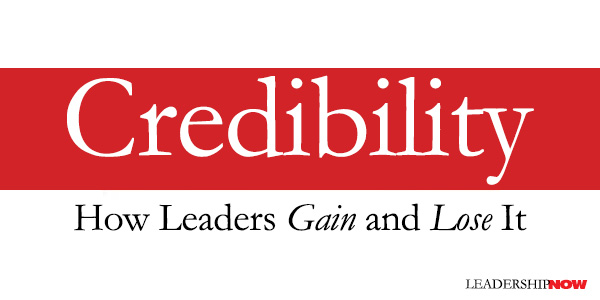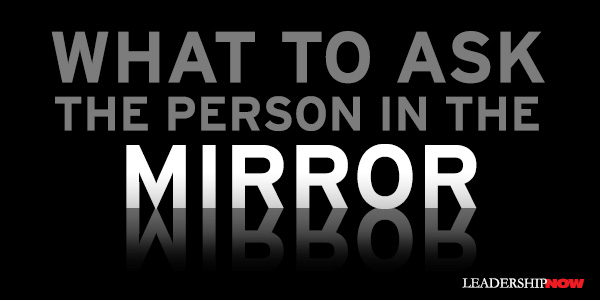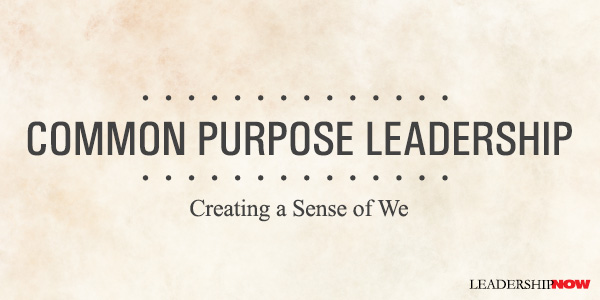 Leading Blog | Posts by Month |
 Leading Blog | Posts by Month |
08.31.11

LeadershipNow 140: August 2011 Compilation
Posted by Michael McKinney at 03:12 PM
08.26.11

Credibility: How Leaders Gain it and Lose It
CREDIBILITY is the foundation of leadership. Unfortunately, many people today do not trust their leaders. “Many wonder if there are any leaders left who have the strength of character to sustain their trust,” write Jim Kouzes and Barry Posner in Credibility: How Leaders Gain it and Lose It – Why People Demand It. While there is no single reason for it, “there is the gnawing sense in many corridors that leaders are not competent to handle the tough challenges; that they are not telling the truth; and that they are motivated more by greed and self-interest than concerns for the customer, the employees, or the country.” The time is ripe to revisit this topic. Credibility is a wake-up call to get back to the fundamentals; to remember that leadership is about relationships. “The secret to closing the credibility gap lies in a collective willingness to get closer, to become known, and to get to know others—as human beings, not as demographic categories, psychographic profiles, voting statistics, or employee numbers.”The process of building and sustaining credibility requires six disciplines: discover your self, appreciate constituents, affirm shared values, develop capacity, serve a purpose, and sustain hope. The authors devote a chapter to each of these issues. Personal responsibility is key to building and restoring credibility. Personal responsibility means understanding not only your actions, but the likely consequences and attending to them. Kouzes and Posner suggest following the “Six A’s of Leadership Accountability”: accept, admit, apologize, act, amend, attend. Leadership isn’t easy and in a constantly changing world, things like credibility and competency can seem elusive. But if we act on a daily basis, “in ways that increase people’s belief that we are honest, competent, inspiring, and forward-looking, people will be much more likely to want to follow your direction.” When leaders walk the talk, others are more likely to follow. Some leaders think that credibility once demonstrated and earned, is complete. But it must be renewed daily in everything we do. Unfair or not, it is the life that a good leader has chosen and demonstrates the understanding that the function of leaders is to serve, not be served. Credibility is an important book to help you sustain your influence. They conclude: Renewing credibility is a continuous human struggle and the ultimate leadership struggle. Strenuous effort is required to build and strengthen the foundations of working relationships. Constituents do not owe leaders allegiance. Leaders earn it. The gift of another’s trust and confidence is well worth the struggle and essential to meeting the challenges of leading people to places they have never been before. 
Posted by Michael McKinney at 04:46 PM
08.25.11

How Character Erodes
CHARACTER is built choice by choice, decision by decision. And it is eroded the same way. We often don’t stop to think about how each choice builds on the last until it’s too late. It is a worthwhile practice to think about your choices and where they are leading you on a daily basis. Ralph Waldo Emerson put it well: “The force of character is cumulative.” In a October 2002 Fast Company article—The Secret Life of the CEO: Is the Economy Just Built to Flip?—Jim Collins, explains how character erodes: These were the people who, in the presence of an opportunity to behave differently, got drawn into it, one step after another. If you told them 10 years ahead of time, "Hey, let's cook the books and all get rich," they would never go along with it. But that's rarely how most people get drawn into activities that they later regret. When you are at step A, it feels inconceivable to jump all the way to step Z, if step Z involves something that is a total breach of your values. But if you go from step A to step B, then step B to step C, then step C to step D ... then someday, you wake up and discover that you are at step Y, and the move to step Z comes about that much easier.”
Posted by Michael McKinney at 10:14 PM
08.22.11

Relationship Trouble? Try Another PerspectivePeriods of crisis and testing are helpful for what they bring to our attention. When things are going well it is all too easy to ignore the hard issues we would be better served by addressing. Times of testing show who we really are.Diana Smith identifies one such issue in The Elephant in the Room: relationships. “No longer,” Smith writes, “can we count on slow markets or sloppy competition to make up for the inefficiencies poor relationships create. We face a crisis not only of leadership but of relationship.” When faced with a relationship problem, there are two ways we can look at it: Individual Perspective: Based on the assumptions that there is one right answer, people either get it or they don’t get it, and when they don’t, their dispositions are largely to blame. Relational Perspective: Based on the assumptions that different people will see different things, that solid common ground can only be found after exploring basic differences, and that the strength of a relationship will determine how well and how quickly people can put their differences to work. “The assumption that ‘you alone are responsible’ and ‘you are either mad or bad’ lead people to locate the cause of problems in individuals and outside their own influence.” The relational perspective actually puts you in the frame of mind to take responsibility for any part you may have in the difficulty. Reflecting on the relationship between Churchill and Roosevelt she observes that “they looked to the other’s circumstances, not his character, to find out why” they did what they did. Karl Popper wrote in Conjectures and Refutations, “While differing widely in the various little bits we know, in our infinite ignorance we are all equal.” Smith says that understanding this “leads people to assume that we all see things others miss, that disagreements are inevitable and valuable, that those disagreements will at times cause frustration, and that people will be better off if they help each other build relationships that can handle those differences well, especially under pressure. While it makes sense to take the relational perspective, it can be hard to do especially when we are in the heat of the moment. One reason for this is that it is hard to step out of the moment and reflect on and reframe the situation in a productive way. And when we do reflect it’s easy to get sucked into what Smith calls “armchair reflection.” This is reflection that is really nothing more than gossip, blaming, imputing motives and conclusions like, “He just doesn’t get it.” It doesn’t lead to understanding and a forum for the other person to fill in what is missing from the picture. Not all relationships are created equal and Smith offers techniques to sort those out too. But when we want to improve a relationship, if we are waiting for the other person to change, she says we’re in for a long wait. “To improve a relationship, you need to focus on changing the relationship, not just yourself or the other person.” Smith offers tools and practices to do this. Before you even begin to work on a relationship, there is an interesting paradox to think about: “They know each other so well, they no longer know each other at all. All they see are the caricatures in their heads—he’s so sensitive, she’s so competitive.” Smith adds that despite the “very efficiency these caricatures give, they also take away because they make a person’s underlying complexity—sure to emerge under stress—harder to handle or to understand. That’s why, early on, the single most important thing people can do is slow down and take a closer look at each other and how their relationship works. Your effectiveness as a leader depends on your relationships. The Elephant in the Room highlights a better perspective to take than the standard individual perspective we usually employ in dealing with our relationships. A relationship is a system of behaviors that can be analyzed and understood. Smith’s insights will help you to productively influence them.
Posted by Michael McKinney at 03:50 PM
08.19.11

What to Ask the Person in the Mirror
WHILE we might like to think otherwise, here is a fact about successful leaders: Successful leaders go through significant periods of time in which they feel confused, discouraged, and unsure of themselves and their decisions. They feel as if they should be somewhere else, doing something else. And unsuccessful leaders go through the same thing. The difference, says Harvard professor Robert Kaplan, is “how they deal with these periods of confusion and uncertainty. The trick lies not in avoiding these difficult periods; it lies in knowing how to step back, diagnose, regroup, and move forward.” This means not having all the right answers, but learning to ask the right questions. The challenge will be asking the right questions and making to the time to reflect on them. Reflecting is the key ingredient here and what many of us are short on. In his timeless book, What to Ask the Person in the Mirror, Kaplan offers seven basic types of inquiry or areas of focus—actually a system of inquiry that ties the leadership function together—that you should be looking at on a regular basis:Vision and Priorities. In this foundational area we need to be very clear and communicate it in a way that helps others to be able to determine where to focus their own efforts. Have you developed a clear vision and have you identified three to five clear priorities to achieve that vision? Managing Your Time. Your vision and priorities are reflected in the way you use your time. Track your time for two weeks. How does this compare to your key priorities? Giving and Getting Feedback. Most leaders do not effectively coach their subordinates, and also fail to get the critical coaching that they themselves need in order to excel. Do you cultivate advisors who are able to confront you with criticisms that you may not want to hear? Succession Planning and Delegation. When leaders fail to actively plan for succession, they do not delegate sufficiently and may become decision-making bottlenecks. Have you identified potential successors for your job? Why not? Evaluation and Alignment. It is often extremely difficult as an insider to see where you and the organization have drifted out of alignment. If you had to start again, how would you do it? Would you be doing the same things? Does the design of your organization, your incentive systems, your culture, and even your approach to leading still fit the needs of the organization? The Leader as Role Model. Many leaders fail to appreciate that their actions speak louder than their words. Self-awareness is critically important. Write down two or three key messages you believe you send with your behavior. Seek advice from key subordinates and advisors who directly observe your behavior, in order to answer this question: is there a “disconnect” between the messages you wish to send and those you are in fact sending? Reaching Your Potential. Know and learn to manage your strengths, weaknesses, and passions, not only to bring out your best, but also to create this same environment and aspiration among your staff. It’s not uncommon to find leaders that just stick to what they know best and not address those areas where they feel uncomfortable or insecure. All of these areas need to be reflected on as they each have an impact on the other. Taking the time to reflect is not easy and “doesn’t sound like fun, and may not sound as important as the fifty other things you have to fit into your day—but it works.” And be sure to take the time to reflect on these issues with your team as well. With many down-to-earth examples, Kaplan will expand the range of questions you should be asking yourself. What to Ask the Person in the Mirror will help you to rethink unsustainable behaviors that are damaging to both you and your organization and help you to mature and grow in your leadership role. 
Posted by Michael McKinney at 03:57 PM
08.16.11

Hacking the Creative ProcessWhile creativity is associated with artists, creativity is really part of life. It is how we shape our work into something meaningful. Benjamin Franklin put it this way: “To cease to think creatively is but little different from ceasing to live.”You might not think of yourself as being creative, but if you are expected to solve problems, strategize and come up with new ideas, then you are required to be creative. "While a designer will solve a problem visually, a manager may solve it by developing a new process. But they're both using the same creative tools and wrestling with many of the same obstacles." What’s more you are expected to do it consistently and on demand. This isn’t easy. “If you want to deliver the right idea at the right moment, you must begin the process far upstream from when you need that idea,” says Todd Henry, author of The Accidental Creative. Henry believes that you can create faster and more effectively over the long term if you build powerful practices into your life to help you to do so. Ironically, if you are going to thrive in a create-on-demand world, you need structure. “Creativity craves structure. When you establish effective boundaries, you are focusing your creative energy rather than allowing it to run rampant.” Working harder isn’t the answer. An “always on” approach works against you says Henry. “You need to incorporate practices that instill a sense of structure, rhythm, and purpose in your life.” Consistent creativity demands it. In creative work there is the tension between possibilities and pragmatics. Creativity is about exploring, innovation, and the next big breakthrough. But it’s also about budgets and deadlines. It’s easy to get off-track doing creative work. "Because we tend to gravitate toward possibilities, many creative people wrestle with focus." We can become fascinated by the process and never really accomplish anything. Yet we are paid for the value we create. It’s important to be able to articulate exactly what we are trying to accomplish. Henry discusses the assassins of creativity and offer many ways to counter them. One very simple yet profound suggestion is “The Big 3.” The Big 3 is not a to do list, a wish list, or a project list. It is “best described as the three most important ‘open-loops’ in my life and work. They are the three most important items that I’m still looking for critical insight on.” The key thought here is that by identifying them and writing them down, it helps you to filter the stimuli you take in each day through the lens of your most important creative priorities. This technique is a very helpful way of keeping your mind focused and looking for connections to create unexpected insights. Henry also emphasizes the importance of relationships. “We sometimes begin to see the act of maintaining a relationship as an obligation that pulls us away from our important work, rather than as an opportunity to stretch ourselves, explore new possibilities, and take advantage of collaborative opportunities within our team.” You must engage with other people. This is a big point for leaders. When we get busy this always seems like the first thing to go. Big mistake. Relationships give us perspective on our unique strengths, on which of our ideas are most likely to gain traction, and on how we can most benefit the world around us. Our relationships play a vital role in helping us understand how we can get moving on, and devote our best efforts to, the work that really matters.This is an essential read for all knowledge workers. You will find ideas here to help you to reduce non-work, focus on real work, and filter information, to produce better and more consistent results.
Posted by Michael McKinney at 12:35 AM
08.08.11

Common Purpose Leadership
IN Common Purpose, consultant Joel Kurtzman makes the case that excellent leaders build a sense of inclusiveness—a sense of we—within the organization by creating a common purpose. A place where people know what to do and why and understand what the organization stands for. Based on interviews and first-hand experience, Common Purpose lays out how to achieve and then sustain a culture based on a common purpose. For example:
The easiest way to create a sense of we, says Kurtzman, is unfortunately to create the specter of them. Because it is easy, it is probably the reason you see this dynamic played out in so many organizations of all kinds. While it is a shortcut to common purpose, “it can also be a stepping stone to chaos, doom, and organized opposition.” I would add that within the organization or group, it also leads to arrogance, stagnation and closed minds. In most cases, it leads to decline. Organizations are created to achieve goals that “are beyond the capability of an individual to accomplish alone.” They are a method of “aligning groups of people so they achieve common goals.” This is best accomplished when you encourage people to be leaders at any level within the organization. Simon Cooper, president and CEO of Ritz-Carlton, says the best reason to rid an organization of mindless hierarchy is to provide scriptless service: employees deciding on their own how to make guests happy. “They make decisions on their own, on the spot, using their own judgment, and with the sense of confidence that comes from owning their jobs. That’s real leadership.” Taking risks on behalf of the organization. This requires trust at all levels and a different view of real leadership, says Kurtzman. It is difficult to overstress how important it is for teams of people working together to meet informally from time to time…The point is that you cannot lead a team if you do not know the people you are leading, and the best way to do that is informally. “The leader is not separate from the group he or she leads. Rather, the leader is the organization’s glue—the force that binds it together, sets its direction, and makes certain that the group functions as one.” Kurtzman notes, “Leadership is not coaching. Coaching focuses on helping people arrive at their own goals. Whereas leadership, especially common purpose leadership, is about helping people arrive at a collective set of goals. It is about coordinating people’s efforts, aims, ambitions, and capabilities.” Leaders can’t think of themselves as better than their workers or more favored because they have a higher rank. Becoming CEO is not a coronation; it’s a promotion. And CEOs can’t do everything. The purpose of an organization is to combine the efforts of many people to produce results no one on his or her own could achieve alone. Leaders must understand that. They must live the goals they espouse. They must understand that everyone inside the organization is looking at them — scrutinizing them, really — and also that every action of theirs is being watched and talked about. At FM Global, Shivan Subramaniam, the chairman and CEO, decided against buying a corporate jet despite the prodding of his board. Instead, he decided to abide by the same corporate travel rules that every other executive in the company abides by. He even flies on the redeye if he must. By doing this, he sends a powerful signal throughout the company that while he may be the CEO, he’s also an employee, just like everyone else. People value that. People will do almost anything for a leader like that. Of course, one size does not fit all. “People are individuals, and those who thrive in one firm might not thrive in another. Chemistry, fit, values, and many other qualities are in the eye of the beholder.” Kurtzman believes that “organizations will come to resemble constellations of capabilities linked together technologically from centers located around the world….Big companies will comprise smaller pieces, each with unique characteristics, ownership structures, and relationships. Each of these elements, when combined, will create enormous value?” The question is what will keep it all together. Incentives alone won’t do it. “The power of a common purpose will become the factor that differentiates winning organizations from those left behind.” This means that leaders will have to be “kinder, more caring, and more empathic than leaders of the past.” We have seen this increased focus on respect as many of you write, talk, and practice this on a daily basis. Common purpose leadership, at its most basic level, is about recognizing people as individuals. Common purpose leadership begins with respect for individuals and their differences, and goes on to celebrate their strengths. 
Posted by Michael McKinney at 10:59 AM
08.05.11

The Iconography of LeadershipArt critic Robert Hughes discusses the influence of Rome’s art on Roman history in his book Rome: A Cultural, Visual, and Personal History. He points out that like the propaganda of today, statues in ancient Rome perpetuated the power of leaders. He presents the “competent, effective and memorable” statue of the emperor Augustus found in the Villa of Livia at Prima Porta, as an example that has few equals as an image of “calm, self sufficient power.”Hughes writes, “Until the advent of photography and then of TV, which effectively replaced them, propaganda statues were indispensable when it came to perpetuating the iconography of leadership. They were produced in mass numbers all over the world to celebrate the virtues and achievements of military heroes, political figures, wielders of every sort of power over all kinds of people.”  Hughes states that we should not think of this as a unique piece. “The Romans,” he writes, “reveled in the cloning, copying and dissemination of successful images—successful, that is to say, especially from the viewpoint of ideology.” Certainly, whether to perpetuate a myth or a truth, we do the same today. Images create a powerful story.
Posted by Michael McKinney at 03:51 PM
08.03.11

7 Ways to Increase Trust by Creating Stability Uncertain times always invite a little more drama, particularly in the workplace. One reason is because the brain craves certainty. When you feel uncertain, the amygdala, an almond shaped structure in the brain shoots out chemicals through your blood stream that make you experience feelings of fear, doubt and anxiety. Fortunately leaders can use this information to create a sense of stability in an unstable world, which increases and eliminates much of the unnecessary drama plaguing so many workplaces today. Here are seven ways leaders can increase trust and reduce workplace drama by creating a stable environment and seven questions to help you get to the root of the problem. Be clear Just because you are unclear does not mean you have drama, but I can guarantee where ever there is drama there is a lack of clarity in some area. The lack of clarity could be in your policies, mission statement, job descriptions or even the methods of communication. When there seems to be negativity or any other form of drama, ask the question, “Where might there be a lack of clarity?” Be Consistent Often a leader can add to the confusion unintentionally because of personality and wiring. In my book, Stop Workplace Drama I talk about the creative genius boss and the idealist, two traits often found in high driving entrepreneurial types. The creative genius drives employees crazy with “flavor of the month” ideas and emergency deadlines only to change course at a whim. The idealist contributes to lack of consistency by starting out strong then losing momentum when the new wears off, or when realism sets in and resources are scarce. When you see the morale dipping or you sense a lack of engagement, ask the question, “How might my behaviors be perceived as inconsistent?” Shorten the Gap Most of us know from experience that plans that look good on paper don’t always work in the real world. One way to keep clarity and consistency is to shorten the gap. In other words, chunk down the goals into very small measurable parts. The idea here is to give the vision and the overview, but explain that plans may change as new information emerges. Then at the designated stopping places, celebrate the successes and then explain the next few projects and pieces and how the changes will contribute to the stated goals. When you get ready to make a change, always provide a pilot period for the change rather than announce the change is here to stay. When you see negativity, frustration or overwhelm, ask the question, “Where do I need to shorten the gap so it seems easy?” Keep your Word When you are in the midst of change, regular communication, scheduled communication and documented promises are a must. Even a simple, “I’ll get back with you” can create a sense of uncertainty and inconsistency if you don’t do what you say you are going to do. When you say, “I will let you know” or “I’ll get back to you on that,” schedule a time in your blackberry or calendar and make sure you follow through. Make your word golden and you will build loyalty and trust in your organization. When you stop getting ideas, curiosity and questions, ask yourself the question, “Where do I need to follow up or tie up loose ends?” Listen Every time I have interviewed employees on what makes a good boss, listening is always the first response, and respect is the second. Rather than always being the one with the answers, learn how to ask a good question. When you really listen, you increase engagement, which is always a sign of trust. The good thing about listening is remembering that you don’t have to have all the answers. When you start to feel overwhelmed, stuck or confused, ask yourself, “What could I learn from my employees if I was willing to listen?” Respect Before I became a professional speaker and trainer I had some bad habits unbeknownst to me. I would either roll my eyes, or use sarcasm as a way to keep people at a distance when I did not agree or when I felt misunderstood. I was not aware of these habits until someone pointed it out to me. Eye-rolling, interrupting, or using innuendo and sarcasm may keep people in their place, but these habits will also build a barrier instead of a bridge. In addition, you will be viewed as a persecutor instead of as a leader. If you perceive distance from your peers or your employees, ask yourself, “What habits do I have that could communicate disrespect?” Master Your Self William Penn said, “No man is fit to command another who cannot command himself.” As a leader, the worst thing you can do is to let your emotions rule you. No matter what the reason, flying off the handle, cursing, yelling or throwing fits does not benefit your corporate goals or inspire your team. No one wants to work for a bully or a hot head. Excuses such as “that’s just the way I am,” or “You would feel the same way” indicates a lack of discipline and emotional maturity. If you feel the pressures piling up and you have difficulty mastering yourself, ask yourself these questions: “Is my behavior and thoughts adding value,” and “How can I get my needs met so I can represent myself appropriately?” Tumultuous times offer great opportunities to increase your leadership skills. Rather than focusing on the outside circumstances, now is the time to become a creator and lead from within by creating stability even in difficult times. Marlene Chism is a professional speaker, trainer and the author of Stop Workplace Drama. For more information visit www.marlenechism.com or at www.stopworkplacedrama.com
Posted by Michael McKinney at 10:40 PM
08.01.11

First Look: Leadership Books for August 2011Here's a look at some of the best leadership books to be released in August.




For bulk orders call 1-800-423-8273  Build your leadership library with these specials on over 120 titles. All titles are at least 40% off the list price and are available only in limited quantities. “The first law of skillful reading is merely an application of the Law of Relative Importance. You must perceive, first of all, the total offerings of the printed matter; then you must appraise these.” — Walter Pitkin, The Art of Rapid Reading
Posted by Michael McKinney at 07:50 AM
|
BUILD YOUR KNOWLEDGE


How to Do Your Start-Up Right STRAIGHT TALK FOR START-UPS 
Grow Your Leadership Skills NEW AND UPCOMING LEADERSHIP BOOKS 
Leadership Minute BITE-SIZE CONCEPTS YOU CAN CHEW ON 
Classic Leadership Books BOOKS TO READ BEFORE YOU LEAD |
|